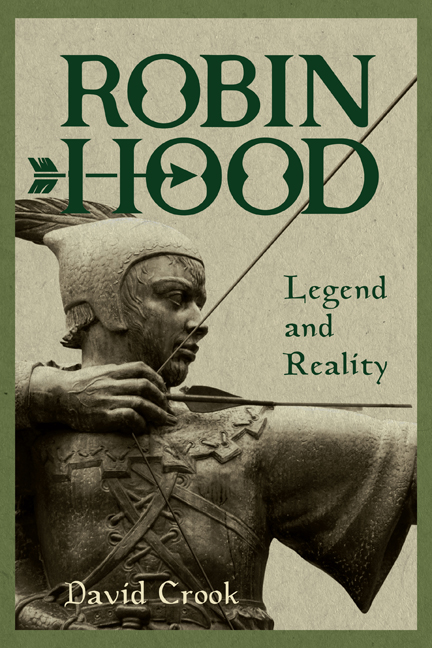Book contents
- Frontmatter
- Dedication
- Contents
- List of Maps and Illustrations
- Preface and Acknowledgements
- List of Abbreviations
- Introduction
- PART I THE LEGEND AND ITS INTERPRETERS
- Chapter 1 The Medieval Tales of Robin Hood
- Chapter 2 Chroniclers, Revellers, Playwrights and Antiquarians, c.1420–1765
- Chapter 3 Editors, the Folklorist and the Archivist, 1765–1889
- Chapter 4 Folklorists, Literary Scholars and Historians: Robin Hood in the Twentieth Century
- Chapter 5 The Robin Hood Places
- PART II OUTLAW AND EVILDOER OF OUR LAND: THE ORIGINAL ROBIN HOOD
- Chapter 6 The Robin Hood Names
- Chapter 7 Robin Hood and Criminality
- Chapter 8 Law and Disorder in Yorkshire, 1215–1225
- Chapter 9 The Sheriff, the Fugitive and the Civil Servant
- Conclusion
- Bibliography
- Index
Chapter 9 - The Sheriff, the Fugitive and the Civil Servant
Published online by Cambridge University Press: 16 September 2020
- Frontmatter
- Dedication
- Contents
- List of Maps and Illustrations
- Preface and Acknowledgements
- List of Abbreviations
- Introduction
- PART I THE LEGEND AND ITS INTERPRETERS
- Chapter 1 The Medieval Tales of Robin Hood
- Chapter 2 Chroniclers, Revellers, Playwrights and Antiquarians, c.1420–1765
- Chapter 3 Editors, the Folklorist and the Archivist, 1765–1889
- Chapter 4 Folklorists, Literary Scholars and Historians: Robin Hood in the Twentieth Century
- Chapter 5 The Robin Hood Places
- PART II OUTLAW AND EVILDOER OF OUR LAND: THE ORIGINAL ROBIN HOOD
- Chapter 6 The Robin Hood Names
- Chapter 7 Robin Hood and Criminality
- Chapter 8 Law and Disorder in Yorkshire, 1215–1225
- Chapter 9 The Sheriff, the Fugitive and the Civil Servant
- Conclusion
- Bibliography
- Index
Summary
In the five surviving early tales of Robin Hood the outlaw has various enemies, but the only one who appears in all of them is a sheriff, and all the tales refer to one particular sheriff only, the ‘sheriff of Nottingham’. In none of them, however, does the sheriff appear as anything like a character with a personality (with the slight exceptions of Robin Hood and the Potter, where he briefly becomes a figure of fun, and the third fytte of the Gest, when he complains of the discomfort of spending a night in the forest wearing only his breeches and shirt). He seems simply to be an archetype, an anti-hero representing the enforcement of authority against the heroic outlaw, and no specific information or suggestion about the origins and nature of the enmity between them is given in any of the early tales. According to Dobson and Taylor, he
plays so fundamental a role in the legend that he may have been more crucial to its origins than Robin Hood himself. In the Gest … one is left with the overall impression that it was the sheriff's presence in Nottinghamshire that drew Robin to that county rather than that it was Robin's activities in Sherwood which compelled the local royal agent to move into the centre of the legend.
They also speculatively suggested that stories about him ‘arose independently from and perhaps even preceded those concerning Robin Hood’, and that the legend was ‘an amalgam of two originally distinct story cycles’, one centred on a Yorkshire outlaw from Barnsdale and one on a Nottinghamshire sheriff. It is difficult, however, to imagine a type of popular story in which a sheriff was heroic, and the idea does not fit with the plot of that other tale of yeomen outlaws, Adam Bell, Clim of the Clough and William of Cloudesley, the earliest text of which dates from 1536 but which is certainly of medieval origin. The three heroes were ‘outlawed for venyson’ and lurked in Inglewood Forest in Cumberland, near the town of Carlisle, whose justice and sheriff jointly play the role of official villain, although in this tale the justice is the senior figure.
- Type
- Chapter
- Information
- Robin Hood: Legend and Reality , pp. 228 - 255Publisher: Boydell & BrewerPrint publication year: 2020



